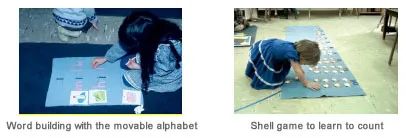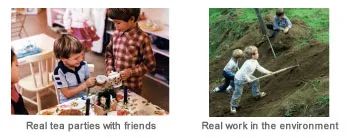The Absorbent Mind
The absorbent mind is one of the most important ideas in early childhood education. Maria Montessori presented this fundamental concept to the world more than a hundred years ago from her initial observations of children. The absorbent mind makes our adult lives possible.
 The absorbent mind is the sponge-like capacity to absorb from the environment what is necessary to create an individual from his or her specific culture. It is the quality of the child’s mind up to the age of about six, when there is a transition to the reasoning mind we have as adults.
The absorbent mind is the sponge-like capacity to absorb from the environment what is necessary to create an individual from his or her specific culture. It is the quality of the child’s mind up to the age of about six, when there is a transition to the reasoning mind we have as adults.


Every little child learns to speak his mother tongue. And no one teaches him the vocabulary, the grammar, or the syntax. It happens every day in every country at just about the same time. It’s a rather amazing feat! If you have tried to learn a foreign language later in your life, you know it is not so easy. Yet every little child does it effortlessly. How? Through the absorbent mind. If the child is in an environment where she hears the language, she will speak it. As the child absorbs words and their meaning along with the context and the emotions behind the words, she begins to construct the ability to communicate.
Children absorb not only their language, but the traits of their families and communities. They learn how and what we eat, and how to behave in certain situations. Some of it is consciously taught, but a great deal of it is simply absorbed through this powerful child mind. Children absorb through a process Montessori called “mental chemistry,” and actually build themselves and their identity through what they absorb.
To compare the absorbent mind with the reasoning mind, let’s compare a photograph with a drawing.

Both of these images are of a cup. In the photograph, every detail is captured exactly as it is: the color, the texture, the angle, the background. It is fixed and it remains as it was at the moment the picture was taken. In the drawing, the detail is as much or as little as the artist chooses. It may be the artist’s idea of the cup rather than any specific cup, and it may or may not include background.
The absorbent mind is more like the camera. What the child takes in during the absorbent mind period is taken in effortlessly and remains as the foundation of his or her personality. What the child takes in later in the reasoning mind is taken in through conscious work and memory, and is not so foundational to the personality.

Montessori’s understanding of the power of the absorbent mind in the first six years of life is a great gift. It teaches us that we can prepare a rich environment for the young child and, as he simply lives in the environment, he absorbs from it and learns. In the Montessori early childhood program for ages 2½ through 6, we introduce the children to all manner of interesting activities, including language, mathematics, the sciences, music, art, and geometry.

Through the power of the absorbent mind, we can give our children a broad and deep foundation, when it is completely effortless for them to learn. Through the amazing “mental chemistry” of the absorbent mind, the child build his or her identity with wide interests. The child learns through self-chosen, engaging activity and builds a solid base habit of thoughtful concentration and structured learning.





















